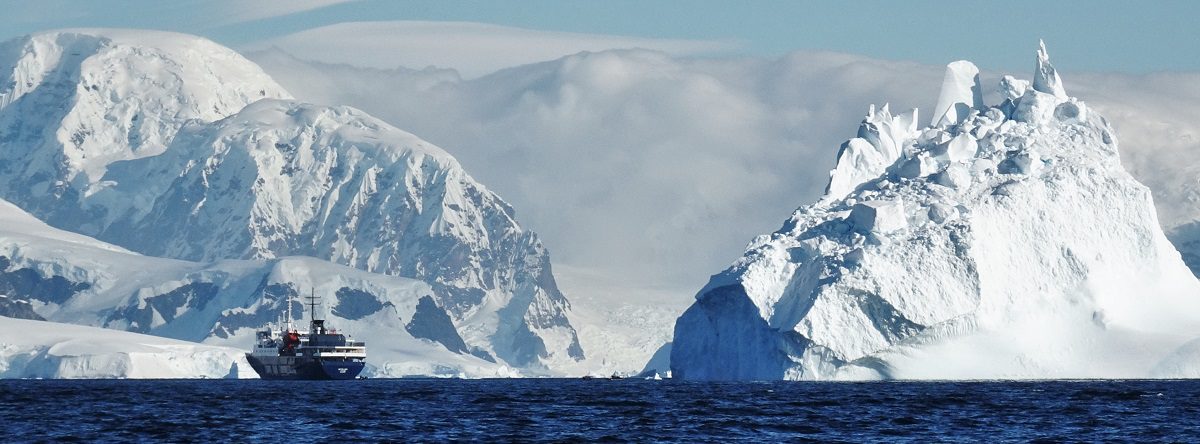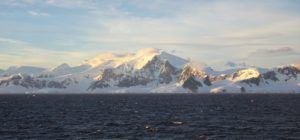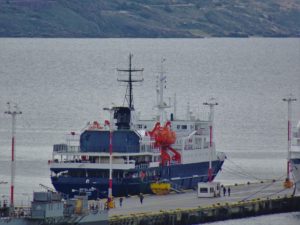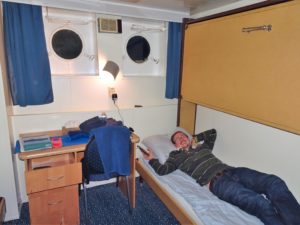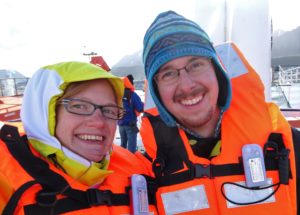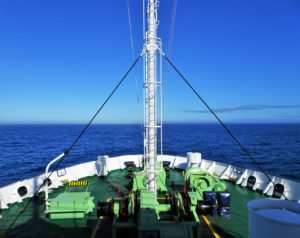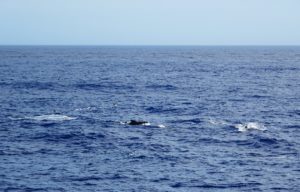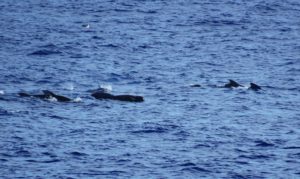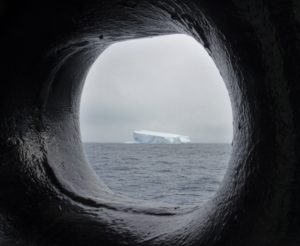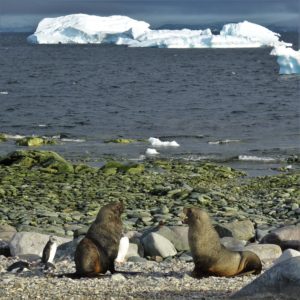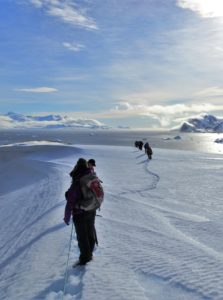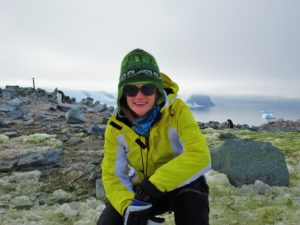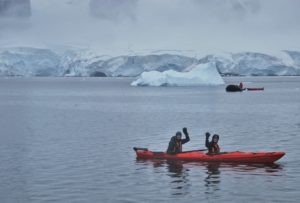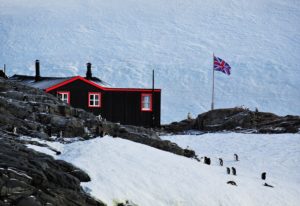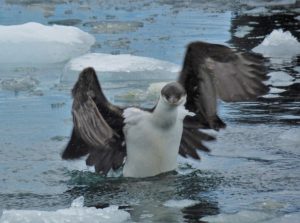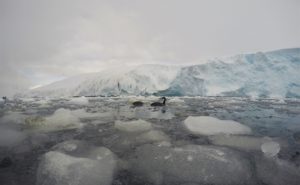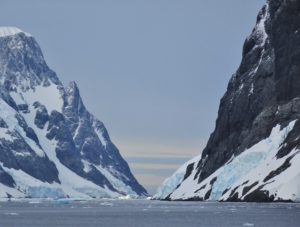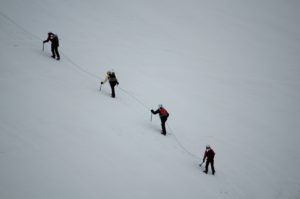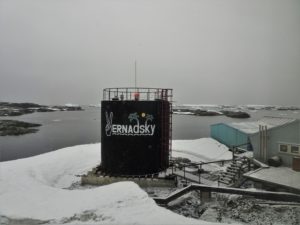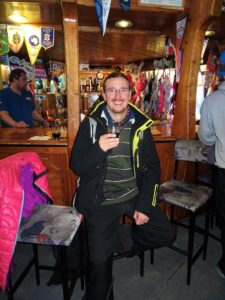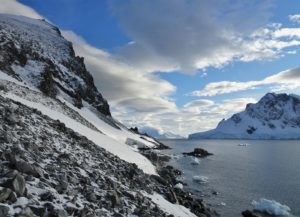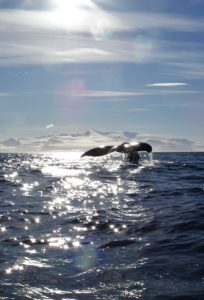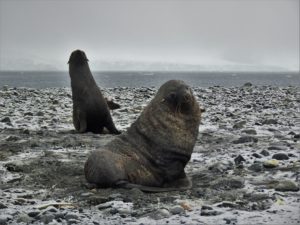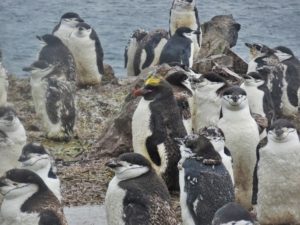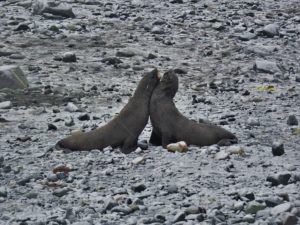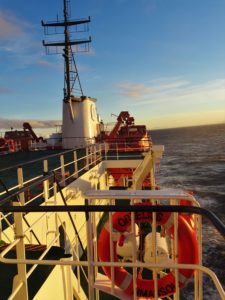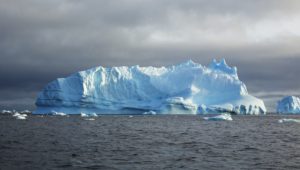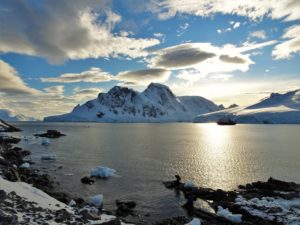Today marks one year to the day that we embarked on our journey to Antarctica. Life and work have kept us very busy since we’ve been back in the UK, but we’ve got our act together and here is a mammoth blog post on what was our most amazing adventure.
When we left the UK in September 2015 this was not a post I ever expected to write. Our extravagance for this trip was our visit to the Galapagos islands, which was an incredible experience that we’ll never forget. At the back of our minds however was something that we’d read suggesting that it might be possible to go to Ushuaia on the southern tip of Argentina and get a last-minute trip to Antarctica.
The dream of many travelers is to get a free or very cheap trip to Antarctica by volunteering to work. The reality is that unless you have an in-demand skill and are lucky enough to find a position, this is not really an option. Most crews do full seasons of hard work for low wages and are unwilling to take on inexperienced staff. Adeline, who we met in Argentina, was lucky enough to find a short-term post as a ship’s photographer (her incredible photos are here) but we don’t really have useful skills for Antarctic ships. This left us with the option of going to Ushuaia in the hope of finding something.
It has been a dream Alex’s to visit Antarctica since University if not before. I could never really understand why as it sounded cold and barren to me, but she was the expert thanks to her studies. In all honesty I never thought that this would be remotely achievable. After all, what I did know was that it was both far away and extortionately expensive.
After speaking to a few people we met on our travels we discovered that a last-minute deal in Ushuaia was indeed a possibility. After Christmas we emailed both of our employers to enquire about the possibility of extending our sabbatical and were surprised when both companies quickly approved a month’s extension. This left us torn as returning home later meant that we’d miss the stag and hen do’s of some of our closest friends, but crucially we’d still be home in plenty of time for the wedding. For a long time we couldn’t decide, but eventually decided that this was too great an opportunity to miss. Being already in South America, with the flexibility to book at the last-minute and wait until a cheap option came up, meant that this was really was a once in a lifetime opportunity.
Decision made, we confirmed our plans with our respective employers, informed our friends about missing their events (thankfully we have wonderfully forgiving friends) and started emailing companies in Ushuaia for deals. The initial responses were disappointing with discounts being only up to around 40% (we managed to get 50% off the Galapagos trip, so that was our benchmark) and even then the prices were still more than we could afford. We also discovered that the cheapest options usually involved staying in a shared four person single sex cabin which meant that we wouldn’t be able to share. For us this would have taken a bit of the fun out of the trip. Undeterred and with plenty of traveling to get on with, we carried on and kept an eye out for better deals.
We checked again a few weeks later and to our horror there were almost no last-minute deals available. We were coming towards the end of the season so maybe we’d missed our chance and this was a dream that would go unfulfilled. There wasn’t anything more we could do whilst on the road so we decided to forget about it and check again once we reached Ushuaia.
Upon our arrival in Ushuaia the first thing we did was to visit the Antarctic tourist office. They had a list of all the latest deals from the agencies. The prices were no better than we’d previously seen, but there were deals available. We went straight to the agency who’d been the friendliest of the ones Alex had spoken to and asked about a couple of the deals on offer. She described one of the cruises which had a more adventurous ‘base camp’ itinerary. As opposed to most of the trips which are more like traditional cruises (in that you stop a few times and have a walk around, see a lot but with little variation in the activities), the base camp itinerary had kayaking, camping for a night on Antarctica, a photography course, snowshoeing, climbing and glacier walking all included in the price. We’d seen camping prices on other cruises at $250 per person per night and kayaking at an eye watering $1000 per session and understood that the likelihood was, as last-minute bookers, the activities would be totally booked up. For me the possibility of spending the night camping on Antarctica was something that I couldn’t miss, and after we’d thanked the lady and walked off to check our next agency I was sold and talking to Alex, quickly realised that she was too. The next agency was busier so while we waited to be seen we looked at their list of last-minute cruises. Sure enough in the window was the Base Camp option at the same price as we’d been quoted with a note saying “1 room left”. Seeing that note we both realised that we’d be devastated to miss out so we walked straight back to the first place and booked immediately. We had a tense few hours while the agency waited to receive the confirmation of our booking, but were delighted and more than a little relieved when we finally received the confirmation e-mail.
We were going to Antarctica!
The shock took a little while to settle in, especially since it was accompanied by the realisation that we’d just spent most of our remaining budget on a 12 day trip. We’d been comfortably under-spending for a lot of the last six months partly because we’d spent so much time travelling with people who were much younger than us and travelling on a tighter budget. We’d managed to build up a little surplus and were looking forward to enjoying a little of the high life in Buenos Aires. We had already worked out what we could afford and, although we’d now have to carefully watch our budget after we returned from Antarctica, we knew we’d be alright and this was an opportunity we didn’t want to miss.
We spent the next week in a daze waiting for our departure date and trying to live as cheaply as possible (which Alex described in her Ushuaia post). Eventually the day arrived. Neither of us had slept well through a mixture of nerves and excitement but when I opened the curtains that morning I could see our boat docked in the harbour and it suddenly became very real.
The boat we travelled on was the M/V Ortelius, named after a 16th Century Dutch cartographer and geographer. She was built in Poland in 1989 and served as a Russian research vessel before eventually being fitted out for tourists. She is smaller than many of the boats with a maximum capacity of 118 passengers and 50 members of staff. Finally she also has an ice strengthened hull of a much higher standard than many of the other boats operating in Antarctica.
Day 1
At 4pm we walked into the dock and boarded the boat. We checked in and were given the keys for our cabin. The cabin itself was basic, but we’d been able to book a twin room with two portholes so at least we had a view outside. The decor in the room was a little like an 80’s Travelodge, but the room itself was bigger than I’d expected and the bathroom had obviously been refitted pretty recently. We had a desk and a wardrobe with plenty of space. But we had no time to unpack as we needed to explore and then head to the bar for a greeting. After a short welcome we were sent down to the lecture room for a mandatory safety briefing, followed by a full evacuation drill which included a roll call on deck in our life jackets and a tour of our assigned life raft.
Once this excitement was over we had another assembly in the bar for a welcome drink and proper introduction to the crew, and before we knew it, it was time for dinner. We’d heard that the food could be pretty variable on the cheaper cruises so were pleasantly surprised when the vegetarian option was a vegetable curry and even more surprised to find cardamom and cloves in it, two spices we hadn’t seen or tasted in months. Before we could taste the food however the announcement came over the intercom from the captain ‘humpback whale breaching at 5 o’clock off the port side’. We all rushed outside to see, in the distance, a fountain of water a few hundred metres away followed by the flap of an enormous tail into the air. This was the first time either of us had seen a whale, so even though it wasn’t the closest sighting we stayed to watch and saw the tail come out of the water a few more times as we passed.
Surprisingly tired from the excitement of our day we finished our dinner and retired to bed. I’d spent the afternoon on the boat totally in awe of what we were about to do. So much so that when we talked to others on the boat all I could say is ‘this is amazing’. They must have thought that I was there on a sponsored care in the community programme, but I didn’t care I was having the time of my life.
That night we sailed along the Beagle channel, exiting out to the sea and the Drake passage just after 10pm. The Beagle channel was totally flat but around 10:30pm once we’d moved away from land we started to pitch and roll in the swell of the sea.
Day 2
We slept until 5am when we could no longer sleep because of the rocking of the boat. At 7:30am we received a wake up call over the intercom from our enthusiastic Australian expedition leader telling us that the sea was calm, and calling us to breakfast. It didn’t feel that calm as we lurched through the boat, bouncing off the walls like a pair of drunk toddlers. Breakfast was excellent and was followed by a series of lectures on the activities that we’d be taking part in. Since the first two days would be spent crossing the Drake passage, the crew were using the opportunity to brief us on as much as possible while there was not much else to do. By mid-morning we were both starting to feel a little seasick so Alex took a pill, and when I noticed only half an hour later how much better she was feeling I followed her lead. From speaking to our fellow passengers it was obvious that most were either feeling sick or had already taken medication. Sure enough by lunchtime I was feeling much better.
Around 16:45 the call came over the intercom that there were pilot whales in front of the boat. We rushed outside and saw pod after pod of pilot whales, up to 200 of them in total. One of the crew members remarked that in years of exploring the Antarctic she’d never seen more than 8 pilot whales together. The whales were accompanied by a pod of hourglass dolphins. The boat slowed right down and the whales passed right in front of the boat, coming right out of the water as they did so.
The rest of the day was taken up by more briefings and dinner. Maybe it was the seasickness pills or the sea air, but by the time we’d finished dinner we were happy to head straight to bed.
Day 3
The next day was our final day in the Drake passage and our last day of prep. We had mandatory briefings on how to behave on Antarctica, plus biosecurity preparation which included hoovering all the clothing and equipment that we’d be taking on land to cut the risk of bringing new life forms onto the continent.
We’d discovered all of our groupings for the activities. If all went well we’d be mountaineering the following morning, so we had a final mountaineering briefing where we were taught how to put on harnesses and crampons.
During a talk about penguins in the afternoon a call came over the intercom that we’d spotted our first iceberg, so we rushed outside to see the boat pass between two huge icebergs. During dinner we sighted land for the first time so we rushed outside again to see the sun setting over an Antarctic island.
The mountaineers were to leave the boat first in the morning and since we were in the first group we were to be the first on the boat to set foot on Antarctica, a continent that less than 500,000 people have ever been on and even now sees less than 40,000 tourists a year!
Day 4
We received a surprise 05:30am wake up call and were invited to come outside to see the sunrise. We were warned however to make our way out via the bridge as the wind outside the boat was blowing at 55 knots. Alex was pretty sleepy but I cajoled her into getting up (normally it’s the other way round) and we staggered outside. The wind was ferocious but the sky was beautiful and we could see snowy mountains either side of us. We were heading along a channel with islands on one side of us and the Antarctic mainland on the other, so this was our first sight of Antarctica. We alternated warming up in the bridge and taking photos outside until breakfast. As the sun rose the mountains were lit up pink and orange, it was a truly spectacular sight.
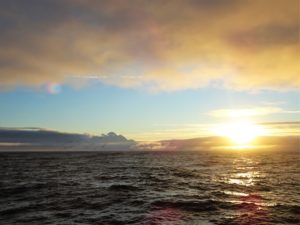
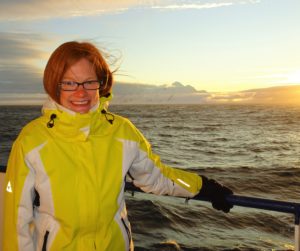
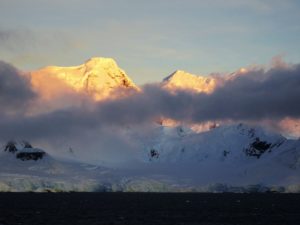
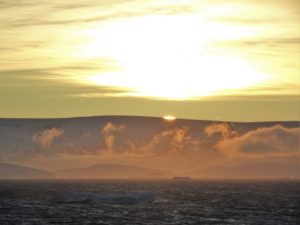
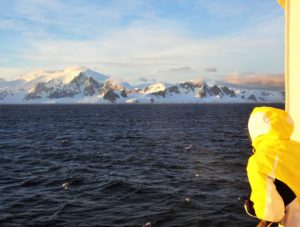
After a suitably heavy breakfast we collected our mountaineering gear. We were ready early and into the first Zodiac. I was at the front and as we stepped onto land I realised that I was the first tourist on our ship to stand on Antarctica. The area we landed in was full of Gentoo and Chinstrap penguins and we smelled them long before we saw them. After landing we clambered through an area that was several inches deep in penguin poo (hence the smell) before finally making it onto some snow. The biggest surprise was the large number of dead penguins, we were at the end of the breeding season and there were juvenile penguins everywhere, but the unseasonably warm weather had apparently caused a higher mortality rate.
Once on the snow we put on our crampons and harnesses and were roped up to our instructor. Our group consisted of three couples and a documentary maker, and we were all roped onto a safety line together.
We’d been issued with ice picks and we made our way up the snow and ice with one hand on an ice pick and the other grasping a walking pole. As it happened, although our guides were very experienced, it was their first time in Antarctica so they were just as excited as we were. Over two hours we made our way up an ice slope gaining about 200m in altitude. Every few minutes our guide would spot a potentially dangerous crevasse in the ice and would carefully test the snow to ensure that we were not all about to fall to our deaths. Luckily the crevasses were all small and stable enough that we could just step over them, but quite a few people still managed to fall waist deep into the ice. Eventually we reached the top of the hill. We had climbed around 200m and now had an amazing view. We were still only on an island, but we couldn’t tell as behind us the snow seemed to go on forever.
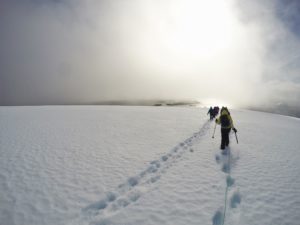
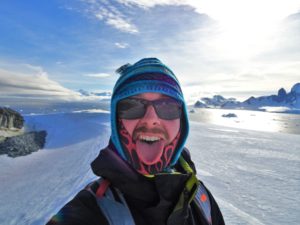
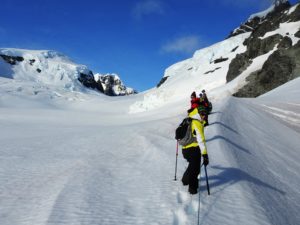
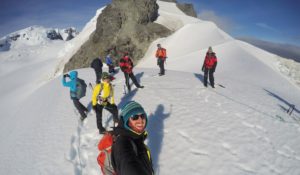
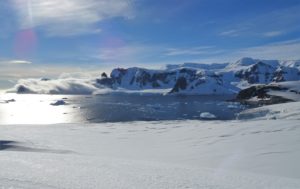
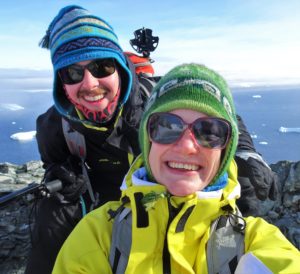
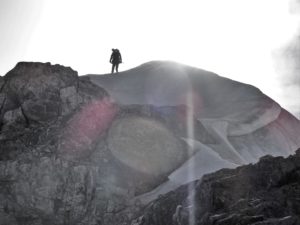
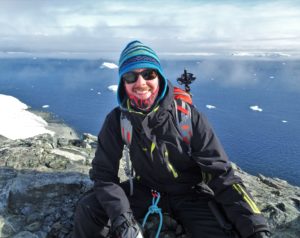
After a few minutes at the top we slowly started to make our way down. The way down was a lot faster since we were no longer climbing, the guide had marked all the crevasses so we were retracing our own footsteps.
Once back at the boat we disinfected our boots, changed out of our wet gear and went for lunch. During lunch the boat moved so we now had a new landing spot for the afternoon. We had no special activity lined up so we were just going for a walk on the land. We boarded the Zodiacs and were dropped off on a beach full of penguins. We climbed up a hill covered in Gentoo penguins and made it all the way to the top which was another 200m climb. The majority of the penguins were juveniles and either still had their fluffy feathers or were just losing them. The parents were constantly arriving and climbing the hill to feed their chicks. Every now and then a nearly fully grown chick would decide that it hadn’t been fed enough and would chase its parent back down the hill before eventually giving up. We also saw a lot of dead penguins and a few lying down looking like they’d given up. All this time predatory Skua birds were circling looking for weak or dying penguins to eat. It was a very strange scene with every stage of life and death represented all on one hill.
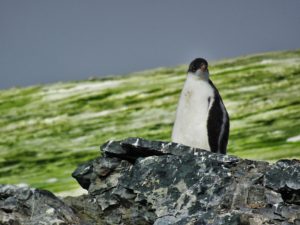
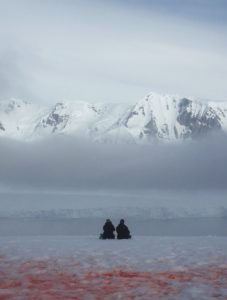
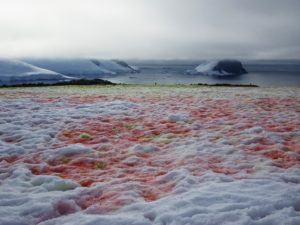
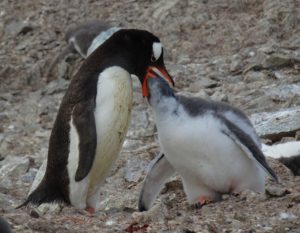
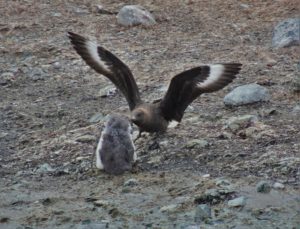
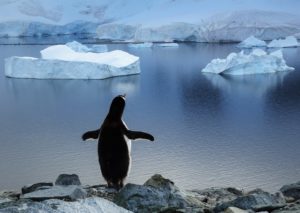
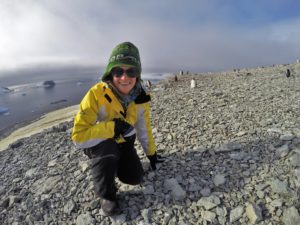
After we got back to the boat we had the usual evening briefing followed by a gin and tonic at the bar.
Day 5
Our morning landing was to be our first on mainland Antarctica. We split into two groups with the first group landing ashore and the second going on a zodiac cruise around the shore. I’d signed up for a photography workshop so we made sure that we were in the first group ashore. Our landing this morning was at Argentina’s Brown Research Station. It wasn’t much of a base, made up of a few rusty shipping containers converted into buildings, but Alex had a chat with one of the staff members and discovered that they were researching how the freshwater melt was affecting algae and sediment levels. She managed to conduct the whole conversation in Spanish so I was suitably impressed. When I went to find Bruce, the expedition photographer, I was surprised to find that I was the only person to turn up to his photography workshop. It was a pretty grey day so maybe the others had decided it was not worth it. Whatever the reason, I ended up getting a personal photography lesson from Bruce learning about his techniques. He gave me a few tips for the camera, and showed me how to look for good compositions. I’ve definitely taken a few good shots since, so maybe some of it sank in! While I was getting the photography tuition Alex had climbed a snow covered hill and slid back down. We followed this with a zodiac cruise where we saw lots to penguins and a few Crabeater seals, taking our seal species spot up to two.
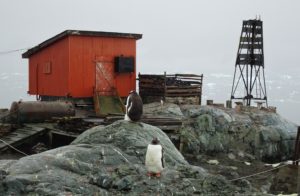
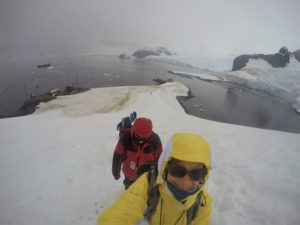
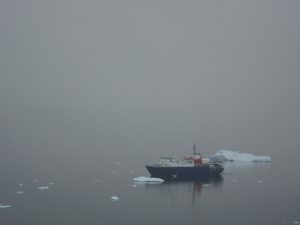
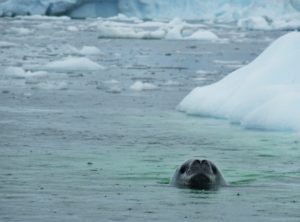
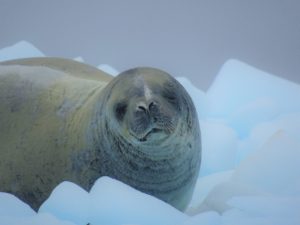
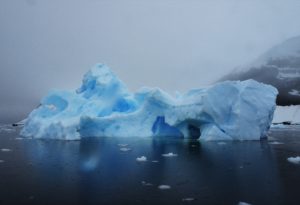
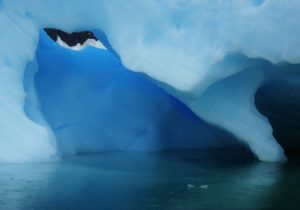
After a hearty lunch we had a kayaking session with Louise the kayak instructor. Although kayaking around Antarctica sounds pretty cold, we were given wetsuit dungarees, neoprene booties and a life vest, plus we wore a t-shirt under the dungarees and our coats on top, and finally we had spray decks to seal the tops of the kayak, trapping warm air in and water out. We climbed into two-man kayaks from a zodiac and paddled in circles to warm up. Alex and I got the hang of it quickly since we’ve done quite a bit before, but unfortunately two Chinese couples found it a little harder. We kayaked for two hours through icebergs and smaller pieces of glacial ice. We explored shorelines and both Alex and I really enjoyed it. Although the mountaineering was great fun we both still preferred the kayaking, even in the rain. However, after two hours we were wet through and freezing cold, so were not too unhappy to get back to the boat and have a shower.
After our evening briefing and dinner it was our turn to camp for the night. Since it was now snowing, the team had decided that we’d be sleeping in tents instead of bivvy bags which we weren’t too upset about as it was freezing cold outside. As it got dark we climbed into a zodiac and were taken to a small island. The tents were already setup and we quickly claimed one and set up our kit. The tent wasn’t great and they seemed to have a shortage of pegs to secure it, but luckily we still had our bivvy bags so we slept inside the bivvy bags inside the tent. This kept us totally dry and the two sleeping bags that were provided kept us nice and warm. We actually slept reasonably well, or at least I did, Alex struggled a little. Overnight it stopped snowing but the wind picked up enough that I woke up a few times with the sound of the tent flapping over my head, Alex heard the guides get up at one point to make sure none of us had blown away!
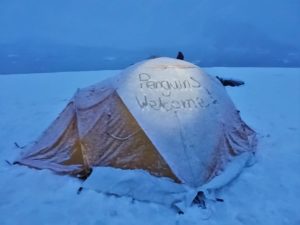
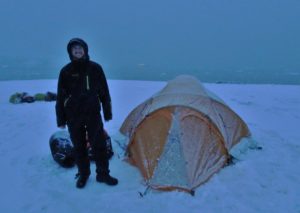
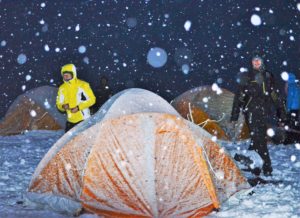
Day 6
We were woken up at 5am to pack up and get back to the boat. It was getting light but still freezing cold. Probably the most unpleasant part of the trip was having to get out of the sleeping bag and put on my trousers followed by my slightly damp and very cold outer gear. Imagine that moment when you wake up warm in a sleeping bag in a tent and have to unzip it and get out. Now imagine it’s -20 degrees Celsius outside the sleeping bag and you’ll get an idea of why I was happy to stay put! I was very cold as we headed back to the boat and very glad to get back to our room. We were back early enough that we were able to shower then sleep for an hour before the alarm call for the boat to wake up and go for breakfast.
Our morning’s outing was to visit Port Lockroy, formerly know as Antarctic Base A, Britain’s first occupied Antarctic settlement. Originally built as a secret project during the second world war it was used for research until 1962 and then abandoned until 1996 when it was designated as a heritage monument and restored by the UK Antarctic Heritage Trust. It is now staffed during the Antarctic summer and we were the last visitors of the season.
The original research base is now a museum, the post office has been reopened and the decayed Nissen hut has been replaced with a modern replica that the staff use. The base was important for lots of Antarctic research and the conservation staff still do some work studying the effects of the human visitors on the penguins that inhabit the area around the base. The last boat taking mail had already left so the postcards that we sent would spend the winter in Antarctica before being collected in November when staff return. Our boat returned the next morning to collect the staff from Port Lockroy in order to take them back with us to Ushuaia.
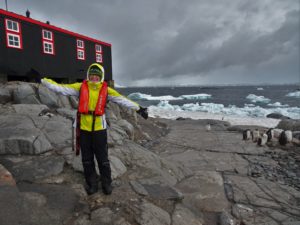
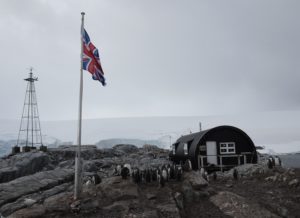
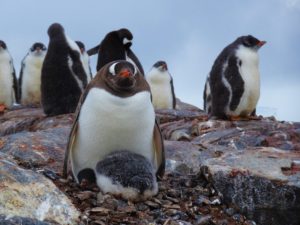
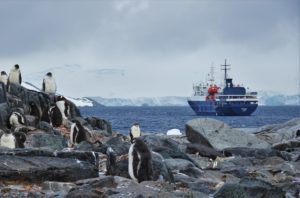
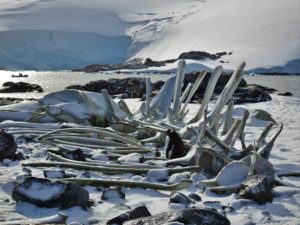
The museum itself was really interesting and the UKAHT had obviously thoroughly researched the history of the base and restored it in an as sensitive and authentic a way as possible.
The sea had been a bit choppy this morning and the zodiac ride to and from the boat had been a little more bumpy than usual. Over lunch the boat moved to our afternoon’s landing site, however when we arrived they quickly announced that it was too windy to do anything so they were trying to work out an alternative.
A few minutes later the boat relocated to a bay nearby which nobody except the captain had been to before and although there was very little landing space they were able to find somewhere for the mountaineers to climb, somewhere for the divers to dive and for the rest of us a zodiac cruise around the bay. Unlike our previous bay this one was incredibly calm and we were treated to a zodiac cruise on tranquil waters filled with melting glacier ice and rimmed by glaciers. We saw a couple of Weddell seals and we took many, many photos of the beautiful scenery around us. After two hours in the zodiacs we started to get a little cold and headed back to the boat.
At the day’s briefing they announced a sign up sheet with 15 places for mountaineering the next morning and luckily after dinner we were able to get two of the spots. At this point we were halfway through our time on Antarctica, with three more days at Antarctica followed by two on the Drake passage.
Day 7
Our day started early as we were woken up at dawn to watch the boat pass down the Lemaire channel, a narrow passage with high mountains on both sides. It was initially doubtful whether we’d be able to pass through it as there was a lot of ice, but the captain proceeded to the entrance and to everyone’s amazement decided to carefully proceed through it instead of going around. There were many ice flows in the channel and all around us we could see Crabeater and a few Weddell seals sleeping on the ice. We were quite lucky with the weather and the visibility was good enough that we could see the tops of the mountains around us, and all the way down the channel.
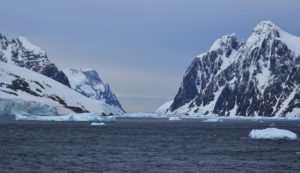
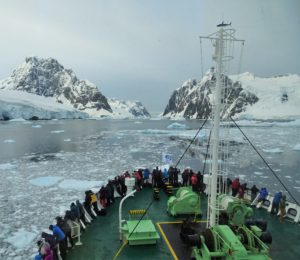
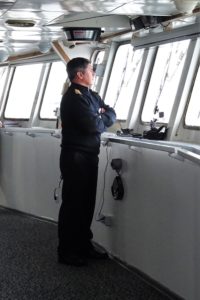
At the far end of the channel is Petermann island which is where we’d do our second climbing expedition. We collected our gear and disembarked. We walked over to the start point of our mountaineering but took a short detour to see some Adelie penguins, very cute and with a permanently surprised look on their faces. We got to the start of the hill and started to climb. Very quickly it became clear that the hill was quite a bit steeper than the guides had thought, so we stopped and our guide Marcus moved us onto a shorter rope. We continued to climb straight up and eventually to our relief the gradient decreased and we reached the top. We climbed onto a rocky peak and took a look around.
We were standing on the highest point of the island and had a 360 degree view of the sea all around us and the Antarctic mainland across the Lemaire channel. The guides were pretty excited too and we all stopped for photos. Once we’d taken all the photos we wanted we started the descent. This time Mal (the lead guide) went ahead and fixed some anchors into the snow which he attached ropes to. We then descended on our crampons while clipped onto the ropes. For the last section Mal took two people down at a time on a very short rope. This was pretty nerve-wracking and Alex almost slipped, but Mal was an expert and we all got down safety. While we had been at the top about 30 of the passengers had done a polar plunge (a fancy name for jumping into the freezing cold Antarctic sea) which we were pretty relieved to have missed!
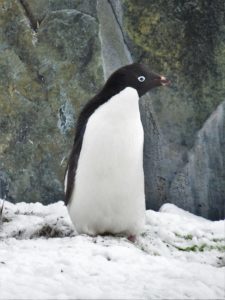
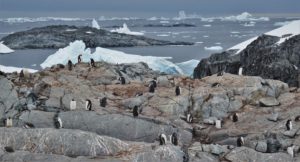
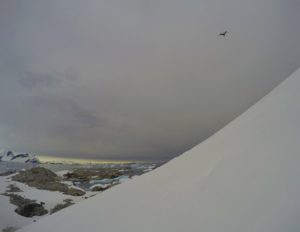
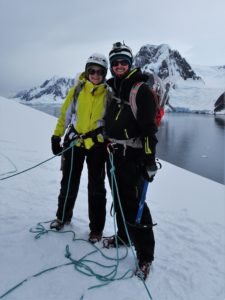
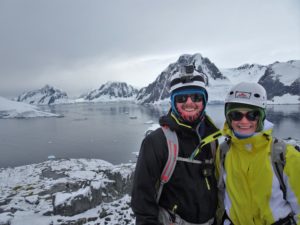
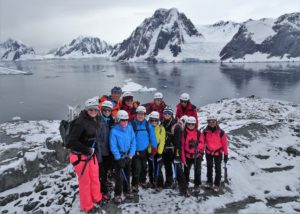
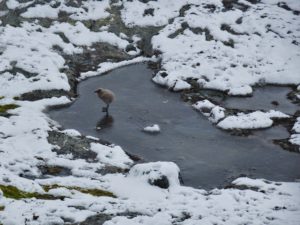
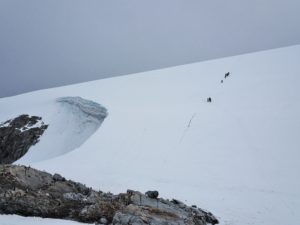
We headed for lunch and the boat started moving to its next destination. Just as we were finishing lunch we got an announcement over the tannoy that there were a number of humpback whales around the ship. We quickly finished our lunch and headed outside. Initially I just saw a few blows in the distance and the occasional tail. All of a sudden two humpbacks surfaced within 10m of the ship and stayed there for a couple of minutes before diving again. Two minutes later they surfaced on the other side of the ship even closer to us. Again they blew a few times before diving back down and popping up on the other side of the boat. They continued to do this getting closer to the ship each time. They were obviously interested in the boat. Eventually they popped up so close to the boat that it looked like one was actually scratching itself on the hull. We were looking over the side of the boat and they were right below us. Under the water we could see the entire whale. They slowly worked their way forward until they were looking right at the bow of the boat and eventually satisfied, a few minutes later they disappeared before surfacing far away. Everyone was very excited to have seen whales so close including the crew and captain who’d never seen them show such an interest in the ship.
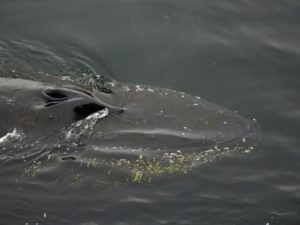
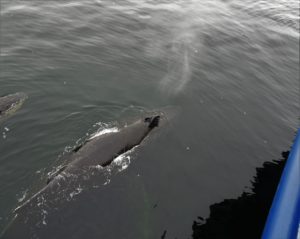
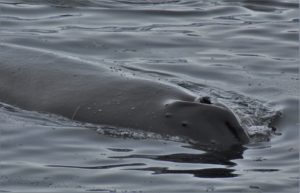
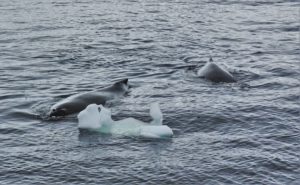
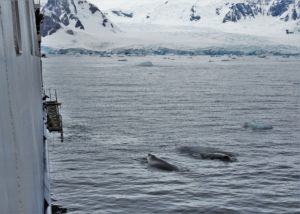
Once the whales were clear the ship continued onto our afternoon stop at Vernadsky station, a Ukrainian research base. Vernadsky station was, until 1996, a British Base called Faraday but when we decided that we no longer needed it, rather than pay to dismantle it we transferred ownership to the Ukraine for £1. The Ukrainians have continued the work there, and on entering the base it is clear that they have made few changes. The photos on the wall still show the British overwintering teams prior to handover, the bar is still called the Faraday bar, and outside there is still a bus stop and a neighbourhood watch sign, obviously put up by British scientists long ago. The staff seemed proud of the history of the base, and since they are much further south and receive few visitors, they were very keen to meet us and to give us a tour of the base.
Before the base visit however we took a trip in a zodiac to see the Wordie Hut, named after a member of Shackleton’s team and only round the corner from Vernadsky station, it is the original base that the British built before Faraday. It has been kept in the same condition that it would have been in during the 1940s-1950s and is maintained by the UK Antarctic Heritage Trust in cooperation with the Vernadsky station staff.
After a walk around the Wordie Hut and drink at the “World’s Southernmost Bar” in Vernadsky station we headed back to the boat.
We were now at over 65 degrees south and this was the furthest south that our trip would take us. The boat turned back round and headed North. We had one more surprise in store which turned out to be a BBQ on the helipad at the back of the boat. The staff had laid out tables and benches over the helipad and they were serving mulled wine, BBQed corn, salad and meat (with a veggie burger for me) which had all been cooked outside on a couple of barrel BBQs. It was snowing but we sat outside anyway eating dinner and drinking mulled wine as we sailed back up the Lemaire channel. The captain even turned the boat at a wider part of the channel to give us all a good view.
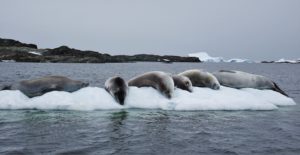
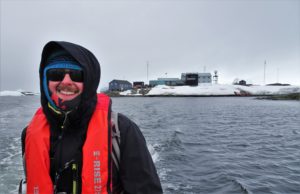
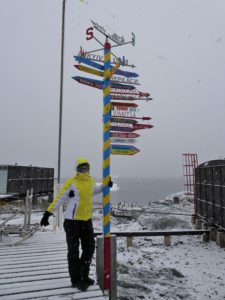
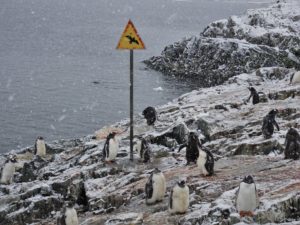
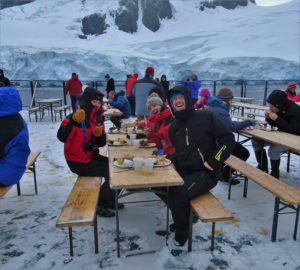
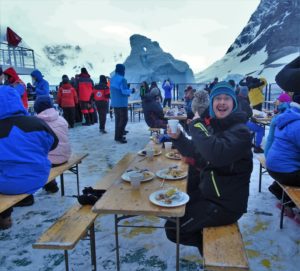
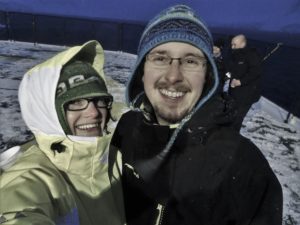
With the free mulled wine everyone had a good time and there was even some dancing on the helipad in the snow. As we left the channel however the wind and swell picked up and everyone headed back into the warmth of the bar. We sat around for a while chatting to a few people and eventually headed off to bed.
Day 8
Our day started as usual with breakfast. We’d put our names into a hat for another opportunity to kayak but we found out that we hadn’t been picked which was disappointing, however a few minutes later the morning’s kayak was cancelled due to the wind being too strong.
After breakfast we made a landing at Orne harbour where we were supposed to be able to climb a little way up a mountain, but when the expedition team investigated they found a thin layer of snow on top of hard ice so only the mountaineers could climb it while we were restricted to the beach. This didn’t leave us with a huge amount to do so we walked along the beach which was strewn with large pieces of glacial ice. The weather was beautiful and sunny so it was nice just to walk and enjoy the view of the mountains. After the walk we took a zodiac ride around the bay and saw some Crabeater and Weddell seals.
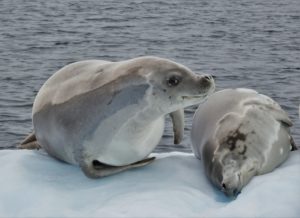
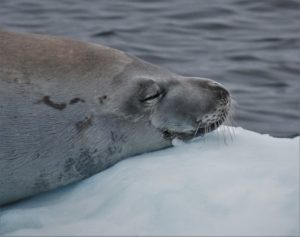
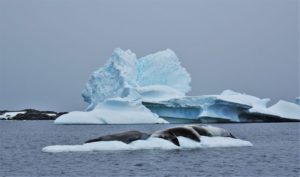
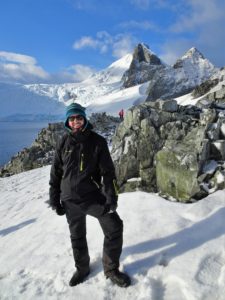
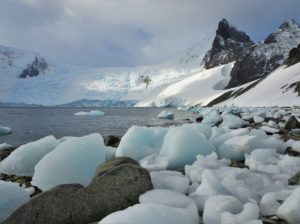
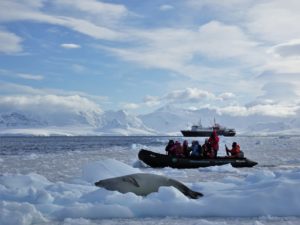
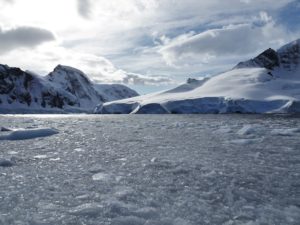
We eventually headed back to the boat and during lunch we moved to Foyn Harbour. This time the kayakers got their trip while we took a zodiac ride due to there being no suitable landing spots. The weather was still beautiful and the bay contained the decaying hull of a wrecked whaling ship that had sunk there in the early 20th century. Before we could get there however we were diverted as humpback whales were spotted in the bay. The zodiacs all raced over to where the whales had last surfaced, but they were nowhere to be seen. Suddenly two humpbacks breached around 3m away from us. They stayed there for around two minutes before diving, sticking their huge tails into the air so that we got an incredible view before they disappeared. Two minutes later they again popped up so we raced over and took more photos they were so close that when they blew their breath drifted over us which was to be honest pretty foul smelling. A couple of minutes later they disappeared before again appearing a little further away. We again headed over and took some more photos. This routine continued for over an hour. Whales can move surprisingly quickly and the staff made it clear that if the whales wanted to get away from us they could, and their behaviour showed that they were relaxed and feeding. Eventually they surfaced a lot further away so we decided to carry on to find out what else we could see from the zodiacs before we had to go back on-board the Ortelius. We saw some Crabeater seals as well as getting close to the wreck which was a nice end to an incredible afternoon.
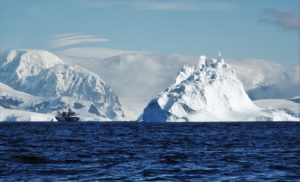
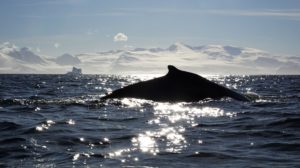
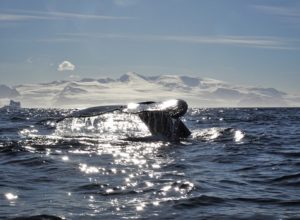
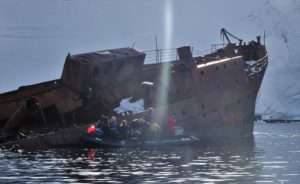
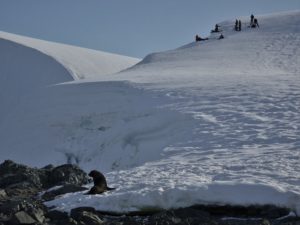
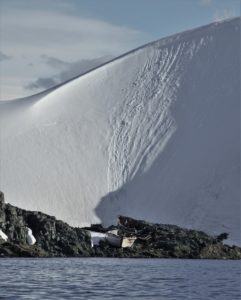
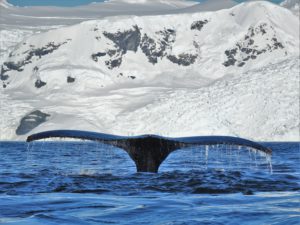
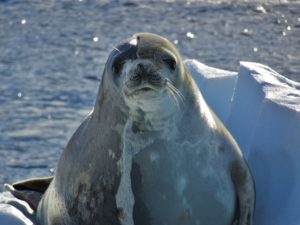
Before we left Ushuaia I had hoped to finally see a whale but I was expecting a tail in the distance. I never imagined that we’d see these incredible creatures so close or for so long. Despite being so large they seem to be incredibly gentle and graceful in the water. They surface making barely a ripple in the water and when they disappear their tail slides gently beneath the waves, not with a violent slap as I’d always assumed.
Day 9
This was our last day on Antarctica and in fact was only a half day as we had to head north in the afternoon to begin our crossing of the Drake passage. Our destination for the morning was Half Moon Island and we immediately faced difficulty when we found an iceberg parked where the boat normally anchors. After finding a new landing spot we headed onshore to a beach full of hundreds of Antarctic fur seals. They were in a playful mood which is somewhat dangerous for us. A bite from a seal can be very nasty as their mouths contain a whole host of bacteria that require strong antibiotics to shift.
We had to walk across the island however to see our final surprise of the trip. Half Moon Island is the home of a Chinstrap penguin colony which is interesting in itself, however the highlight is a single Macaroni penguin which has been living among the Chinstraps for a number of years. This was our only opportunity to see a macaroni penguin. With this in mind we carefully walked across the island trying to avoid the seals. Most were sleepy and fairly oblivious to our presence, however a few took exception to us entering their territory and had to be stood up to before they would back down. We got to see the Macaroni penguin, with its fantastic yellow feathers sticking out from its head. The weather was pretty foul, being windy and rainy so it felt much like a walk along an English beach in the winter, maybe a little cooler!
When we returned to our landing spot the tide had gone out and it was full of seals, making it unsuitable so the staff had to find a new spot. While they were working it out we stood around waiting and Alex started to get really cold and wet. Luckily it didn’t take too long and before long we were back on the boat where the staff had hot chocolate with rum waiting for us!
We now had an hour or two while we headed up a channel before we hit the Drake passage so we used this time to have a shower while the sea was calm. We’d been warned that the weather on the sea wasn’t great and sure enough once we left the shelter of Antarctica the boat started to roll around in the swell. During the afternoon we had a couple of lectures concerning some of the fauna that we’d seen and this set the tone for the next couple of days.
There were noticeably less people at dinner as people started to succumb to seasickness and, although neither Alex or I were too bad, we’d felt sick enough to already start taking medication.
Day 10
This was a full day at sea. Just like the way south the day was filled with lectures although now more scientific in nature than instructional. Throughout the day the sea got rougher and by mid afternoon, although we still managed to make all the lectures, we were unable to do anything much. We made it out for a nice if somewhat unstable dinner and got an early night.
Day 11
Day 11 was our final full day on the Drake passage, which was good because overnight the sea had got rougher. I woke up around 5am and was unable to get back to sleep as I was being rolled around in bed. It felt like we were continually being thrown up into the air before landing down hard. The sea slapped violently against the hull and on particularly bad waves the whole boat seemed to shudder as it landed. Eventually morning arrived and we got up for some breakfast. Our day would be a mixture of lectures and a few bits of administration. The sea was still pretty violent.
We had a lecture on whaling in Antarctica led by our kayak instructor who had family links to the whaling industry. We then had a lecture on life at Port Lockroy from the team who’d run the museum. They had joined us on the boat the day after we visited. Our final lecture was led by Andrew the expedition leader on Antarctic Geology and was a lot more interesting than I’d expected. Once we’d settled our bar tab and returned our boots and life jackets we returned to our room to watch a film. At some point during this we finally approached the shelter of the South American continent and the sea calmed significantly. This was good as our last activity for the day was to head up to the bar for a wrap-up where we were shown some of the incredible photos that the divers had taken, received and gave thank yous to the expedition staff, and finally watched a video that Bruce, the photographer, had put together of his best photos of us and the wildlife. We had a final dinner and a few drinks in the bar before getting to bed.
We’d entered the Beagle channel around 9pm so by the time we went to bed the boat was still and we slept well.
Day 12
After an early breakfast we disembarked with our luggage. We had some rented gear to return so we headed over the rental place to return it. We then had a last wander around town before heading over to the airport for our flight to Buenos Aires!
Antarctica was Alex’s dream and not something I’d seriosuly considered, however I am so pleased that we took the trip. It is now most definitely the highlight of our travels and a lovely way to (nearly) end our seven months in South America. We were constantly stunned by the scenery and wildlife that we encountered and this was only helped by the incredible service we received on the Ortelius. The staff took what could be a really dangerous environment and made sure that we had an adventure where we always felt safe in their hands. We now want to visit the Arctic with Oceanwide Expeditions (owners of the Ortelius) but unfortunately, at least from a cost perspective, this is going to have to wait for a few years!

